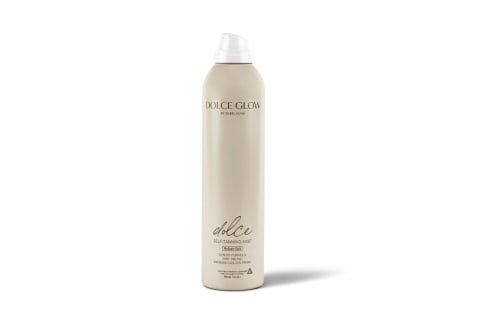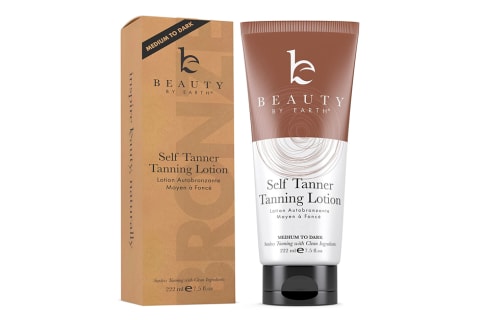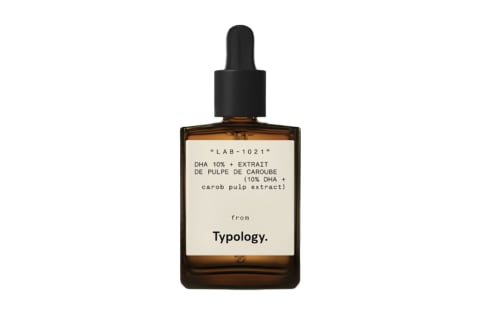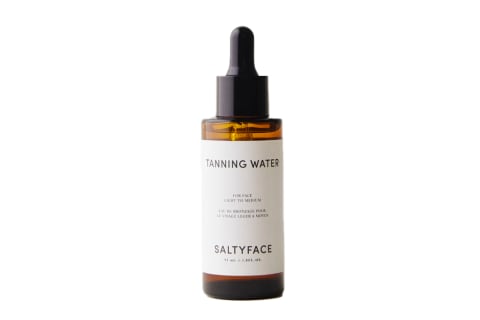The Best Self-Tan Routine For Zero Streaks & All The Glow
Self-tanning is one of those beauty habits that plenty of people try out reluctantly yet end up loving.


Beauty & Health Editor
Beauty & Health Editor
Hannah Frye is the Beauty & Health Editor at mindbodygreen. She has a B.S. in journalism and a minor in women’s, gender, and queer studies from California Polytechnic State University, San Luis Obispo. Hannah has written across lifestyle sections including beauty, women’s health, mental health, sustainability, social media trends, and more. She previously worked for Almost 30, a top-rated health and wellness podcast. In her current role, Hannah reports on the latest beauty trends and innovations, women’s health research, brain health news, and plenty more.
Image by Agafonova Photo / Pexels June 22, 2025 We carefully vet all products and services featured on mindbodygreen using our Our selections are never influenced by the commissions earned from our links. As we kick off summer, we'll be sharing our best advice for achieving Healthy Summer Skin—read all June long. Here’s to a summer of feeling good, living well, and keeping your skin safe under the sun. As the warm, sunny days of summer start to dwindle, there's no better time to soak up the sun—or at least look like you have. Self-tanning is one of those beauty habits that many people try out reluctantly but end up loving—myself included. There's nothing quite like the feeling of looking bronzed and glowy, all without the risk of sun damage. Yet, for many, self-tanning can feel like an intimidating endeavor at first, with concerns about streaks, uneven color, or looking orange. But with the right approach, it can be an easy and rewarding way to maintain that sun-kissed glow, even as we transition into cooler months. Ahead, you'll find a complete guide to self-tanning, including an expert-backed routine, must-know tips, and shopping advice to help you achieve the perfect faux tan.
How to apply self-tanner
We'll dive into how to choose the best tanner next, but let's first get familiar with the application process:
The first step: Get a smooth canvas. "Prepping your skin a day prior to tanning is key to a seamless tan," celebrity tanner and founder of Dolce Glow Isabel Alysa tells mbg. If you don't exfoliate, the dead skin may even block some of the tanner from penetrating.
"I recommend exfoliating and shaving 24 hours prior to tanning so your skin is ready for a golden glow," she adds. You can exfoliate using a body scrub, chemical exfoliant serum, or a gentle exfoliating glove.
Right after you exfoliate, apply a rich body lotion or body cream to ensure you replenish any hydration lost during the process. Then, your skin will be prepped and ready for your tan.
The next day, take a shower to rinse off your body. If you're new to self-tanner or you're using a more pigmented formula, then you'll want to apply a light layer of moisturizer to the knees, elbows, and ankles.
These areas can suck up self-tanner, causing streaking and patchiness. If you apply lotion before, the self-tanner will blend a bit easier in those pesky spots.
Now it's time to grab your self-tanner and your mitt if you have one. These tools ensure that your self-tanner stays on your body, not your hands. But if you don't have a mitt, just be sure to give your hands a good wash before and after applying the tanner.
Squirt your mousse, spray, or lotion onto the body and rub it in just as you would any other body product—but be especially mindful to get every inch. Doing this one area at a time (upper arm, then lower arm, then the front of the stomach, etc.) will make that a bit easier.
If you have a friend or family member close by who can help you apply it to the back and shoulders, you're in luck. Otherwise, consider getting a back applicator like this Two Piece Set from Steugo.
"If you're self-tanning, try a Kabuki brush to blend out those hard areas such as hands, ankles, feet, and knees," Alysa notes. You can also use an old foundation brush if you have one lying around.
Once you've applied tan to your whole body, let it dry for a few minutes, or until you feel the product has fully soaked into your skin. Then, put on loose clothing (a baggy T-shirt, boxer shorts, etc.), and let it set for a few hours, or overnight.
Letting it set overnight makes this process a whole lot easier because you won't be exercising or sweating while the tan is on. Plus, you don't have to worry about tanner getting on your good daytime clothes.
Each tanning product is different, so be sure to check the label for the ideal setting time. Most of the time, letting the product sit longer than the allotted time won't do much, but cutting it short may result in a lighter tan than expected.
6.
Rinse off in the morning
When you wake up (or when your set time is over) rinse off the tan using a gentle body cleanser. In the shower, stay away from things like plastic loofahs and other abrasive cleansing tools, as they might exfoliate the skin and take off some of the tan.
This step is essential—hydrate your full body after you rinse off. After that, kick up your full-body moisturizing sessions to twice per day if you can swing it. "Moisturizing twice a day and keeping yourself hydrated throughout the day truly helps with keeping that tan lasting," Alysa explains.
Look for ingredients that soften the skin and add a bit of shine—think shea butter, coconut butter, and botanical oils like jojoba, squalene, and so on.
Best clean self-tanners
Dolce Glow
Self-Tanning Mist
$49

Beauty by Earth
Self Tanner Tanning Lotion
$36

How to apply self-tan on the face
As for the face, opt for a product specifically designed for the face, like the Typology Self-Tanning Face Serum. You'll follow a similar process but tailored for this gentler area:
Best clean self-tanner for face


How to pick your self-tanner
Now you have the basic routine down, so it's time to dive into shopping details. To follow, a few different things to keep in mind when you're looking for your next favorite self-tanner:
Many products come in two shades: fair to medium and medium to dark. Here's how to choose if you're unsure:
You'll need to choose a type of product you want as well. Here are a few things to keep in mind:
The active ingredient in these topical tanners is referred to as DHA, an abbreviation for the compound dihydroxyacetone. This ingredient temporarily stains the skin but will wash away within a week or so.
Thanks to modern formulation trends, naturally derived DHA can be found in a plethora of tanning products, including many of the mbg preferred picks. Apart from a natural tanning agent, keep an eye out for products that contain even more skin-loving ingredients like hyaluronic acid, shea butter, botanical oils, and so on.
How to make your tan last
After putting in all of this work, you'll want your tan to last as long as possible, so keep these tips in mind:
Cautions
If you choose a high-quality faux tanner (like those mentioned in this article) self-tanning is generally considered to be a safe beauty step. However, it’s important to note that safe tanners do not offer any form of UV protection—so when you’re outside and exposed to the sun, you must still apply sunscreen in order to protect your skin.
As for ingredients to look out for, board-certified dermatologist Apple Bodemer, M.D., notes, “Dihydroxyacetone is considered safe when applied topically, but can be of concern if it is ingested or inhaled, like in professional spray tans. If someone goes that route, they should protect their eyes, nose, and mouth.”
FAQ
Best way to apply self-tanner mouse?
Apply your self-tanner mousse using a mitt. Apply the product to freshly cleansed skin that's been exfoliated (via a body scrub or shaving) a day before. Let the product set for the instructed time period on your product before rinsing it off.
How to apply self-tanner without a mitt?
If you don’t have a self-tanning mitt, you can use your hands. Be sure to thoroughly wash your hands after to ensure you don't have any tan under your nails or in crevices on your hands.
Can I apply self-tanner with a washcloth?
Applying self-tanner with a washcloth may result in the product being absorbed into the towel rather than your skin. Instead, use a tanning mitt or your hands, and be sure to wash your hands with soap and water afterward.
Do you moisturize before self tan?
Tanner is more readily absorbed on dry, parched skin. Be sure to hydrate consistently leading up to the day of application. On the day of, you’ll want to spot-hydrate especially dry skin, such as that on the knees, elbows, hands, etc. Do this about an hour before application.
Should you shower before fake tanning?
Yes, you should shower before fake tanning—as you’ll want to apply the product on freshly cleansed, dry skin. After applying your self tanning product, let it set and dry. Each tanning product is different, so be sure to check the label for the ideal setting time. Many folks recommend doing this before bed, so the tanner can set overnight. After or in the morning, rinse the product off.
Can you shave right before self-tanning?
You should shave before tanning, but not immediately before. For best results, shave the day before you plan to apply fake tanner.
The takeaway
Once you know how to self-tan and you've found a great product, a bronze, glowy look is always at your fingertips, without having to sunbathe and risk damaging your skin.

 MikeTyes
MikeTyes 

































